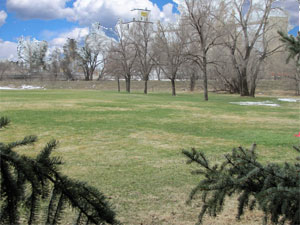- Overview
- Spotlight
- Photos
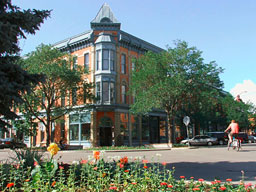
If you’re on Mason Street at the right time of day, you’ll hear a somewhat out-of-place noise rising above the din of the traffic – a train whistle, getting louder and louder as the train comes closer and closer, eventually eclipsing all other sounds on the street. But instead of train tracks running alongside Mason Street, there they are, running right down the middle of it.
A train traveling down the center of Mason Street causes some interesting traffic issues today, but it wasn’t much of a problem in the 19th century when Joseph Mason and the other “City Fathers” of Fort Collins gave the Colorado Central Railroad the land to build a railway, train depot, and rail yards through the northeastern part of the town. At the time, there were few buildings close to the proposed rail lines, and the revenue and resources that a rail line through Fort Collins would bring to the town were immeasurable.
Fort Collins got its start in 1864 when the military post Camp Collins was relocated from Laporte. In 1865, Joseph Mason built and ran the first general store, and his store was soon followed by others. However, Camp Collins was decommissioned in 1867 and Fort Collins struggled not to become another prairie ghost town.
In 1868, the Colorado Central Railroad began building a line that would connect Denver and Golden. Fort Collins officials lobbied hard to have the line extended to include their town, even offering the railroad the right-of-way through downtown on Mason Street. When the railroad finally came to town in 1877, Fort Collins saw a surge in growth. Where the town had a population of a few hundred people in 1870, twenty years later that number had grown to over 2,000. Fort Collins was officially a “boom town.”
Ranching and agriculture drove the town’s early economy and people from across the country and around the world journeyed to Fort Collins. The British, who had been investing in land in the West for years, were joined by the Germans, Scandinavians, French, Russians, and Italians. By the 1900s, Fort Collins was a well-settled town, home of Colorado’s first land-grant college (now Colorado State University), and the possessor of a notable in-town railway transit system. On the railroad line between Denver and Cheyenne, the passenger depot on Jefferson Street in Old Town welcomed the old-timers of the community and the diverse newcomers who supported the growing town.
As Fort Collins grew, the original business district gained the name “Old Town.” Originally, roads in town were laid out parallel and perpendicular to the Cache la Poudre River, making it easy to reach Camp Collins and the resources the river provided. When Franklin Avery was brought in to help plan the expanding community, he designed roads laid out in a compass grid pattern. The two road designs make for some peculiar intersections! The section of town bound by the old street pattern (everything between the river and Mountain Avenue, and College Avenue and Lincoln Avenue) became known as Old Town.
Thanks to a push for historic preservation, Old Town continues to be the heart of Fort Collins and today it’s an excellent illustration of life in the turn-of-the-century Western Plains. In fact, if you’re one of the millions of people who’ve ever visited Main Street USA at Disneyland, Old Town might look familiar. Born and raised in Fort Collins, Disney artist Harper Goff used images of Fort Collins as it would have looked in the early 20th century as one of his inspirations in creating the iconic street.
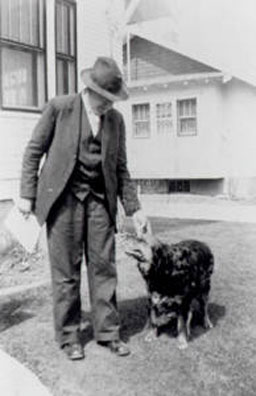
Heading home to Fort Collins, the Colorado & Southern train crew found something they hadn’t unexpected in Timnath, Colorado, during a stopover in 1934—a stray collie pup, starving and pregnant. The men knew that another mouth to feed during these tough Depression days was unrealistic, but they also knew they couldn’t just leave her behind. They decided to take the pup home with them, adopting her as the mascot for the train depot near Old Town.
For the next 14 years “Annie the railroad dog” was the unofficial ambassador to Fort Collins, greeting passengers and winning the hearts of all of those who knew her. A regular celebrity, it was said that disembarking locals greeted Annie before they greeted their own families! When she died, one of the men who brought her to Fort Collins, brakeman Christopher Demuth, fashioned a cement headstone to mark her grave. The epitaph reads: “From C&S men to Annie, our dog, 1934-1948.” Today, Annie is a cherished local legend. A bronze statue commemorates her at the Main Library in Library Park and the “Annie Walk & Pet Fest” is held in her honor annually.
The first railroad to reach Fort Collins was the Colorado Central in 1877, followed by the Greeley, Salt Lake, and Pacific (GSL&P) in 1882. These lines, both subsidiaries of the Union Pacific (UP), were later consolidated into the Colorado and Southern Railway (C&S) in 1898 following reorganization of UP holdings. Trains were the most modern means of transportation at this time, connecting the growing town with the outside world. The arrival of the railroads ended the isolation of the community, providing transportation access and opening up markets for the ranchers and farmers. During Annie’s lifetime, the C&S depot was a busy shipping center serving the region’s livestock, sugar beet, and lumber industries, and recognized as the largest, most completely equipped and modern freight house in Colorado outside of Denver. In the decades after Annie’s death, the railroad industry declined although the C&S depot remained in operation until 1986. It was the longest continuously used rail facility in the region.
In 1995, both the depot and Annie’s grave were designated as local landmarks. In 2001 the depot was refurbished to become the Downtown Transit Center, one of the hubs for Fort Collins' public tranportation system. Travelers can still get a sense of the excitement of “traveling the rails” as Annie did on her journey to the town that became her home.
Interested in historic train depots in Fort Collins? You can find the Colorado & Southern Freight Depot (now the Downtown Transit Center) at 250 N. Mason Street; the Union Pacific Passenger Depot (now the Rodizio Grill) at 200 Jefferson Street; and the Union Pacific Freight Depot (now Cottier Construction) at 350 Linden Street.
Laporte
- Facilities in Laporte
- Restaurant and gas station at Vern's Place, 4120 W County Road 54G
- Groceries available at Overland Foods, 3333 W County Road 54G
- Other nearby historical sites
- Cache la Poudre historical marker, County Road 50E (GPS coordinates 40°37’6"N 105°10’07"W)
- Bingham Hill Cemetery, County Road 50E (GPS coordinates 40°37’6"N 105°08’34"W)
- Historical cabin and DAR marker, County Road 21 (GPS coordinates 40°37’27"N 105°10’07"W)
Laporte, Colorado
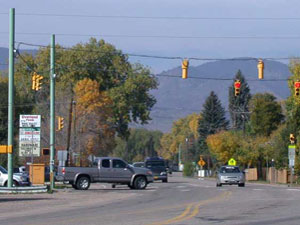
Fort Collins Museum of Discovery
- Location
- 200 Mathews Street, Fort Collins
- Hours
- Tues-Sat 10am-5pm, Sun 12-5pm
- Hours
- The Museum is closed at its 200 Mathews Street location. The new Fort Collins Museum of Discovery will open on November 11, 2012.
For more information, visit our website at fcmod.org
Other questions? Call us at 970-221-6738Old Carnegie Library Building
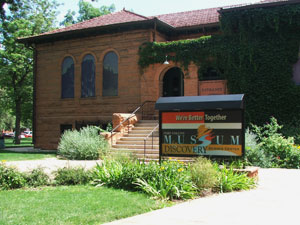
The Fort Collins Museum of Discovery is housed in the 1904 Carnegie Library Building
Old Town Fort Collins
- Parking
- Parking garages are located at the corner of Mason and Laporte, and on Mountain and Remington. For a parking map, click here
- Restaurants
- For a list of Old Town restaurants, click here
- Breweries
- For a list of Old Town breweries, click here
For more information, visit the Downtown Fort Collins website at www.downtownfortcollins.com
Historic Avery Building in Old Town Square
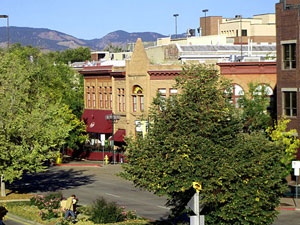
Photo from the City of Fort Collins website
Old Town Heritage Park
- Managing Agency
- City of Fort Collins Parks
- Location
- Old Fort Collins Heritage Park is located at the Northside Aztlan Center, 122 E. Willow Street
- Rules & Regulations
- Read the City of Fort Collins Parks Rules and Regulations here
- Activities & Facilities
- Old Town Heritage Park offers basketball courts, drinking fountains, playgrounds, racquetball courts, a skate park, and a turf area.
The Poudre River at Old Town Heritage Park
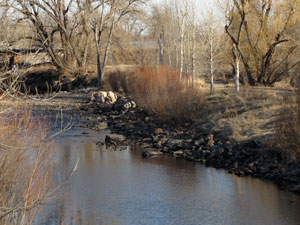
Gustav Swanson Natural Area
- Managing Agency
- City of Fort Collins Natural Areas Program
- Hours
- 5:00 am to 11:00 pm
- Directions
- Parking lot is on Linden Street, between Riverside and Buckingham.
When you visit, look for birds-over 45 species of birds have been seen here including green-winged teal, great blue herons, owls, kestrels, and Bullock’s orioles. Bats, foxes, and deer are also seen here from time to time. Visiting natural areas with a friend or in a group provides the best protection for personal safety.
Free educational programs at Gustav Swanson Natural Area are available for groups by request. Call the Master Naturalist Program at 970-416-2480.
Gustav Swanson Natural Area
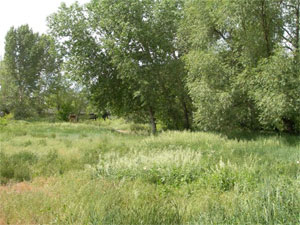
Photo courtesy of the City of Fort Collins Natural Areas Program
Buckingham Park
- Managing Agency
- City of Fort Collins Parks
- Location
- Buckingham Park is located at 101 First Street
- Rules & Regulations
- Read the City of Fort Collins Parks Rules and Regulations here
- Activities & Facilities
- Buckingham Park offers barbeque grills, baseball fields, basketball courts, drinking fountains, playgrounds, restrooms, picnic shelters, and a turf area.
Buckingham Park
